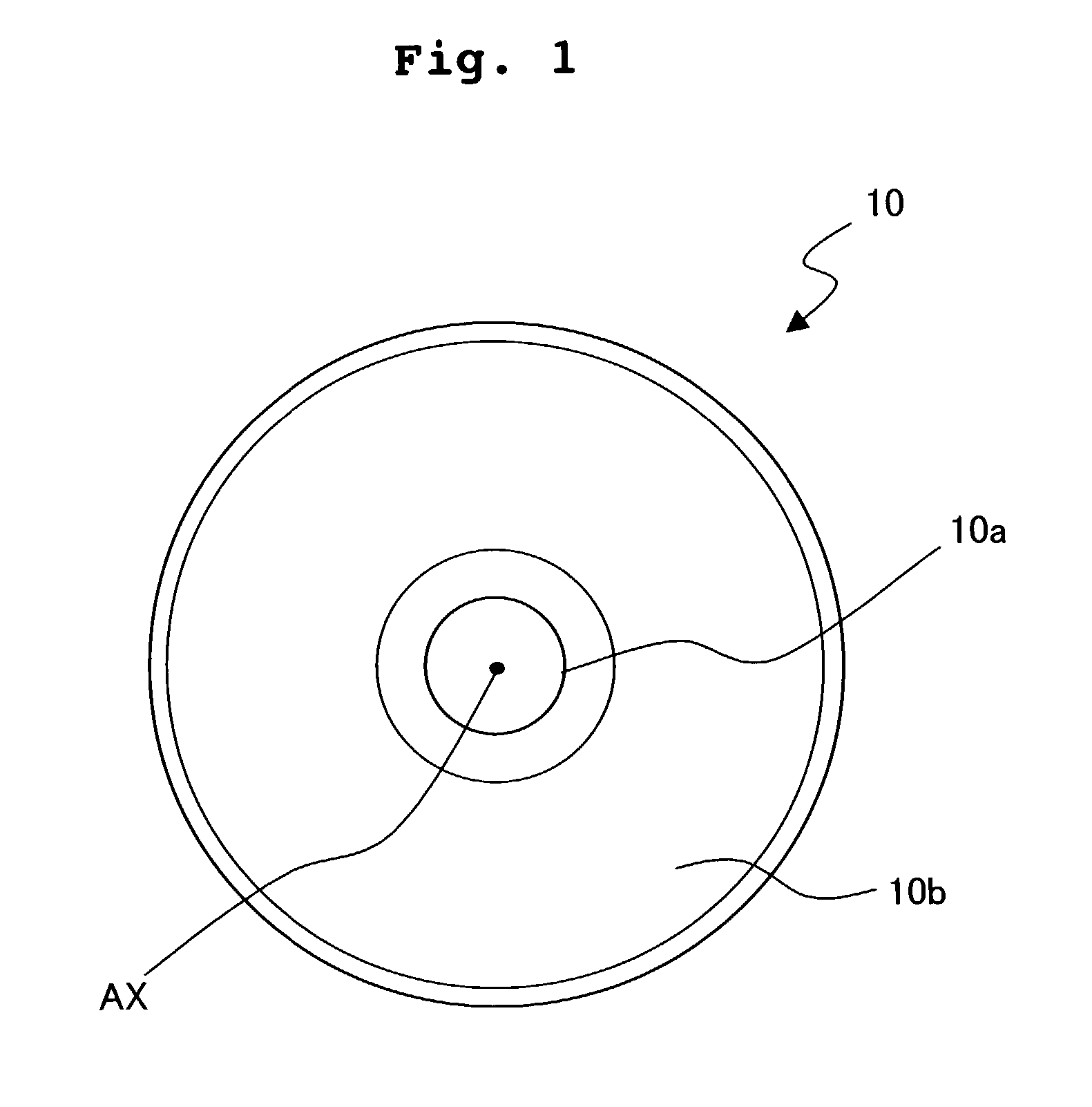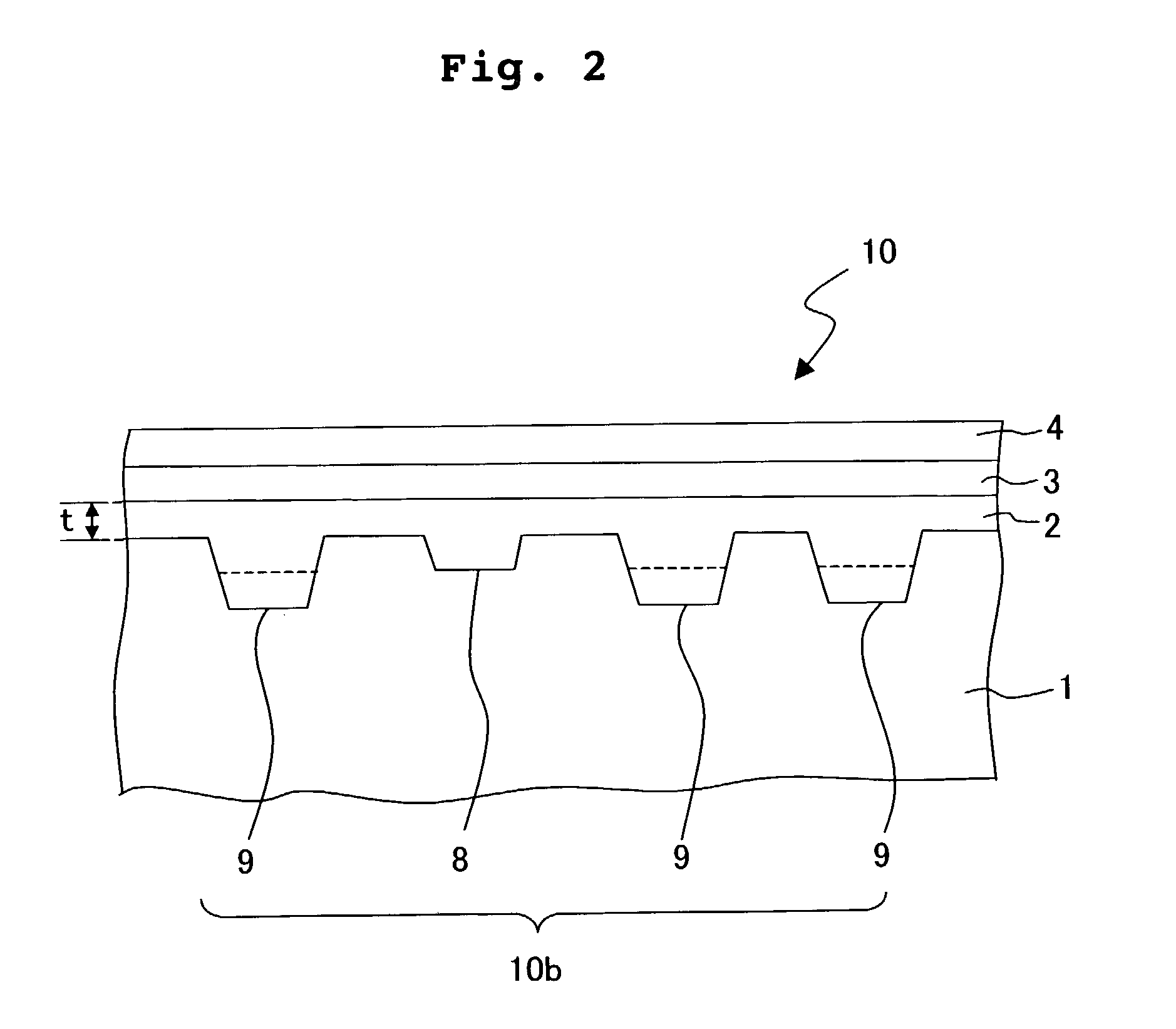Optical recording medium having relation between groove depths and pit depths
a technology of optical recording medium and groove depth, which is applied in the direction of mechanical recording, instrumentation, disposition/mounting of heads, etc., can solve the problems of insufficient exposure amount, inability to accurately form the desired photoresist pattern on the master disk, and inability to obtain any sufficient difference in optical path length, etc., to achieve low jitter, high modulation factor, and low jitter
- Summary
- Abstract
- Description
- Claims
- Application Information
AI Technical Summary
Benefits of technology
Problems solved by technology
Method used
Image
Examples
first embodiment
[0094]An explanation will be made below with reference to FIGS. 5 to 16 about a method for producing an optical information-recording medium according to a first embodiment of the present invention.
[0095]The optical information-recording medium is manufactured by executing a master disk-cutting step of forming a desired pattern on a surface of a master disk, a stamper-manufacturing step of manufacturing a stamper on the basis of the master disk having been subjected to the cutting, a substrate-manufacturing step of replicating a substrate of the optical information-recording medium with the manufactured stamper, and a film-forming step of forming a variety of films on the replicated substrate.
Method for Manufacturing Master Disk and Stamper to Manufacture Substrate
[0096]At first, an explanation will be made with reference to FIGS. 5 to 9 about a method for manufacturing a master disk and a stamper in order to manufacture a substrate 1 of the optical information-recording medium acco...
second embodiment
[0114]Next, a second embodiment of the optical information-recording medium of the present invention will be explained with reference to FIGS. 17 to 19. As shown in FIG. 17, an optical information-recording medium of this embodiment was constructed in the same manner as in the first embodiment except that the preformat pattern formation area was composed of a media information-recording area 170b for recording media information and a user recording area 170c for recording user information. The media information-recording area 170b is formed with a groove having in-groove pits. The media information-recording area 170b is formed within a range of radius of 23.9 mm to 24 mm on the basis of the center AX′. On the other hand, the user recording area 170c is formed with only the groove. The user recording area 170c is formed within a range of radius of 21 mm to 23.9 mm and a range of radius of 24 mm to 58 mm on the basis of the center AX′. The groove depth in the user recording area 170c...
modified embodiment 1
[0117]A modified embodiment of the second embodiment will be explained with reference to FIG. 20. As shown in FIG. 20, the optical information-recording medium of this modified embodiment is an optical information-recording medium comprising a reflective layer 3″, a recording layer 2″, a protective layer 4″, and a cover layer 5″ which are formed in this order on a preformat pattern formation surface of a substrate 1″. Information is recorded and reproduced on the optical information-recording medium by radiating a recording and reproducing laser beam from the side of the cover layer 5″ not from the side of the substrate 1″. Also in the optical information-recording medium, the bottom surface 201a of the groove 201 and the bottom surface 202a of the in-groove pit 202 are formed to be flat. Further, the ratio between the groove depth dg′ and the in-groove pit depth dp′ of the substrate 1″ satisfies the condition of dp′ / dg′201 portion (recess depth of the recording layer ranging from t...
PUM
 Login to View More
Login to View More Abstract
Description
Claims
Application Information
 Login to View More
Login to View More - R&D
- Intellectual Property
- Life Sciences
- Materials
- Tech Scout
- Unparalleled Data Quality
- Higher Quality Content
- 60% Fewer Hallucinations
Browse by: Latest US Patents, China's latest patents, Technical Efficacy Thesaurus, Application Domain, Technology Topic, Popular Technical Reports.
© 2025 PatSnap. All rights reserved.Legal|Privacy policy|Modern Slavery Act Transparency Statement|Sitemap|About US| Contact US: help@patsnap.com



